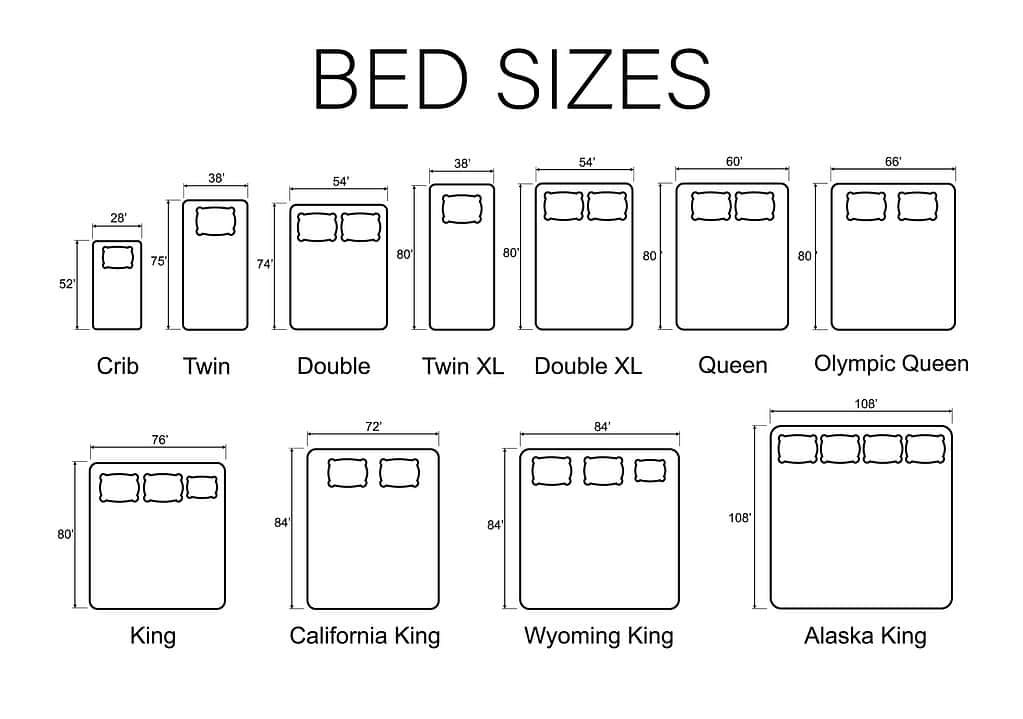6 Common Types of Mattresses Explained
You might be surprised to learn there are currently 6 different types of mattresses on the market today. Each type has unique benefits that can help you get a good night’s sleep.
Finding the right mattress for your specific needs is essential to get the most out of your sleep. The following six types of mattresses are the most popular on the market today:
1. Memory foam
A memory foam mattress is a good choice if you want a firmer mattress and prefer to sleep on your side or back. Since this material conforms to the curves of your body, it’s less likely to cause pressure points. If you’re a hot sleeper, this may not be the mattress for you: memory foam gets warm during the night and can feel especially hot in warmer climates (though some manufacturers offer cooling options). Memory foam can also be expensive, depending on the brand, but it generally has good durability with an average life of around eight years.
A memory foam mattress is a good choice if you want a firmer mattress and prefer to sleep on your side or back. You’ll enjoy the benefits of reduced pressure points and improved circulation. If you’re the type who sleeps hot, though, you may want to steer clear of memory foam as it tends to absorb and retain body heat.
Anyone seeking a more firm mattress will find memory foam a comfortable option that contours to the body to reduce pressure points. If you have any issues with circulation or tend to sleep hot, however, you might want to consider another type of mattress.
2. Pocket sprung
The pocket-sprung mattress is the kind of mattress you might think it is: a series of coil springs in pocketed fabric. These are sewn together in clusters to ensure support and motion transfer but also isolate points of pressure. They’re usually piled up high, so you get that bouncy feeling as soon as you lie down. The great thing about these mattresses is that they’re excellent for couples who cause each other disturbance when they move around at night. It’s also great for those who sleep on their back or side because it provides the proper support.
Those of you who toss and turn at night or who have a partner that does might want to consider a pocket-sprung mattress. These mattresses are designed to minimize motion transfer so you can sleep soundly through the night. They’re also a good option for back and side sleepers, offering plenty of support.
3. Latex
The most common latex mattresses are made from natural or synthetic rubber tree sap. Latex mattresses are hypoallergenic and durable, providing a lot of support. They also have a breathable springy feel that helps keep you cool. Because of their fast response time, latex mattresses don’t need turning.
A latex mattress is a good choice if you’re looking for a hypoallergenic, durable option with a springy feel. These mattresses are also breathable and responsive, so you won’t have to worry about them getting too hot during the night. That’s also a plus for couples since latex mattresses don’t require turning.
4. Hybrid
A hybrid mattress is created by combining layers of foam and springs. Hybrids combine both benefits, with the top layer of memory foam providing comfort while the spring coils add support and durability. Combinations are suitable for all sleeping positions, especially those frequently changing positions throughout the night.
Anyone seeking the benefits of memory foam and springs in their mattress will find that a hybrid model is a good choice. These mattresses are supportive, durable, and suitable for all sleeping positions. That makes them an excellent option for people who often change their sleep position at night.
5. Pillow-top
As the name implies, pillow-top mattresses have pillow-like tops. They are thicker than traditional non-pillow-top mattresses, with a layer of foam material that sits on top of the spring system. The benefits of using a pillow-top mattress include added comfort and support, and they’re accommodating for people who sleep on their side (which is most of us). Some disadvantages to consider when buying a pillow-top mattress are that they’re more expensive, heavier to move around and have less lifespan than other types of mattresses. A misconception about pillow top mattresses is that they will make you too hot while you sleep, which is false. Buying pillows in high-quality materials like moisture-wicking fabrics or cooling gels will keep your head cool and maintain airflow through the mattress while still giving you the comfort and support your body needs to get a good night’s rest.
Pillow-top mattresses are also a good choice for people with back pain. The added foam layer provides support and cushioning, which can help alleviate pressure points. That’s good news for side sleepers, who are more likely to experience back pain than people who sleep on their back or stomach.
6. Orthopaedic
Orthopaedic mattresses are designed to help those with back pain, including conditions like arthritis and osteoarthritis. They offer extra support for the spine and, in some cases, can be adjusted to suit individual needs.
The term “orthopaedic” means different things for different mattress manufacturers. For example, most orthopaedic mattresses contain firmer fillings than normal ones, with a layer of natural materials on top to make them more comfortable. However, not all orthopaedic mattresses are memory foam mattresses – some use filling such as latex or wool instead.
Some orthopaedic mattresses are also known as “medical grade” mattresses because they were initially designed for use in hospitals and care homes.

What to keep in mind when choosing a mattress
- Your sleeping position – Are you a side, back, or stomach sleeper? Your sleep position will dictate the type of mattress that’s best for you. For example, side sleepers need a soft mattress to contour their body, while back sleepers need something firm enough to support their spine.
- Your budget – How much are you willing to spend on a mattress? You can find mattresses at different prices, from budget-friendly options to luxury models. Remember that you generally get what you pay for when it comes to mattresses.
- Your health needs – Do you have any health conditions to consider when choosing a mattress? Not all mattresses are suitable for people with back pain, for example. In this, you’ll need to find a mattress that offers extra support.
- The size of your bed – Make sure to measure your bed frame before shopping for a mattress, as you don’t want to end up with one that’s too big or too small for your bed.
- The return policy – Know the store`s returns policy before buying a mattress. This way, you can always return the mattress if it fits.
Final Thoughts
There are many different types of mattresses, and figuring out which is best for you can be overwhelming. However, keeping your sleeping position, budget, and health needs in mind, you can narrow your options and find the perfect mattress. Take the time to weigh each option and find the mattress that will give you the best nightlights. The effort you put in now will pay off in the long run!



